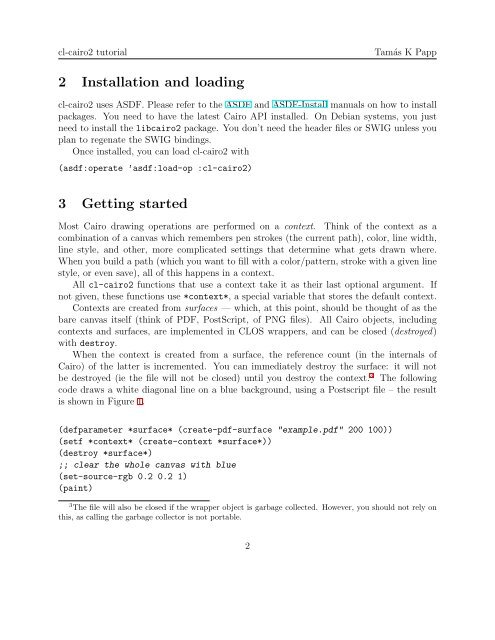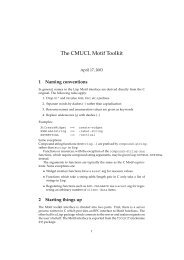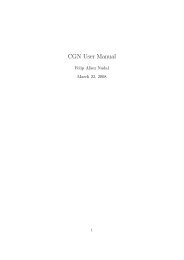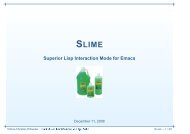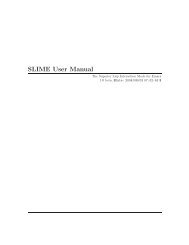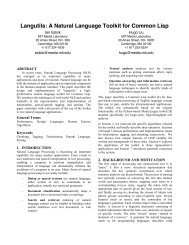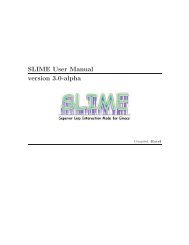Tutorial for the cl-cairo2 package - Common Lisp.net
Tutorial for the cl-cairo2 package - Common Lisp.net
Tutorial for the cl-cairo2 package - Common Lisp.net
- No tags were found...
You also want an ePaper? Increase the reach of your titles
YUMPU automatically turns print PDFs into web optimized ePapers that Google loves.
<strong>cl</strong>-<strong>cairo2</strong> tutorialTamás K Papp2 Installation and loading<strong>cl</strong>-<strong>cairo2</strong> uses ASDF. Please refer to <strong>the</strong> ASDF and ASDF-Install manuals on how to install<strong>package</strong>s. You need to have <strong>the</strong> latest Cairo API installed. On Debian systems, you justneed to install <strong>the</strong> lib<strong>cairo2</strong> <strong>package</strong>. You don’t need <strong>the</strong> header files or SWIG unless youplan to regenate <strong>the</strong> SWIG bindings.Once installed, you can load <strong>cl</strong>-<strong>cairo2</strong> with(asdf:operate ’asdf:load-op :<strong>cl</strong>-<strong>cairo2</strong>)3 Getting startedMost Cairo drawing operations are per<strong>for</strong>med on a context. Think of <strong>the</strong> context as acombination of a canvas which remembers pen strokes (<strong>the</strong> current path), color, line width,line style, and o<strong>the</strong>r, more complicated settings that determine what gets drawn where.When you build a path (which you want to fill with a color/pattern, stroke with a given linestyle, or even save), all of this happens in a context.All <strong>cl</strong>-<strong>cairo2</strong> functions that use a context take it as <strong>the</strong>ir last optional argument. Ifnot given, <strong>the</strong>se functions use *context*, a special variable that stores <strong>the</strong> default context.Contexts are created from surfaces — which, at this point, should be thought of as <strong>the</strong>bare canvas itself (think of PDF, PostScript, of PNG files). All Cairo objects, in<strong>cl</strong>udingcontexts and surfaces, are implemented in CLOS wrappers, and can be <strong>cl</strong>osed (destroyed)with destroy.When <strong>the</strong> context is created from a surface, <strong>the</strong> reference count (in <strong>the</strong> internals ofCairo) of <strong>the</strong> latter is incremented. You can immediately destroy <strong>the</strong> surface: it will notbe destroyed (ie <strong>the</strong> file will not be <strong>cl</strong>osed) until you destroy <strong>the</strong> context. 3 The followingcode draws a white diagonal line on a blue background, using a Postscript file – <strong>the</strong> resultis shown in Figure 1.(defparameter *surface* (create-pdf-surface "example.pdf" 200 100))(setf *context* (create-context *surface*))(destroy *surface*);; <strong>cl</strong>ear <strong>the</strong> whole canvas with blue(set-source-rgb 0.2 0.2 1)(paint)3 The file will also be <strong>cl</strong>osed if <strong>the</strong> wrapper object is garbage collected. However, you should not rely onthis, as calling <strong>the</strong> garbage collector is not portable.2


